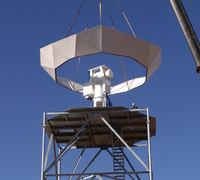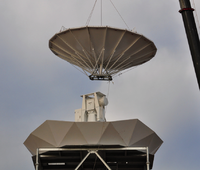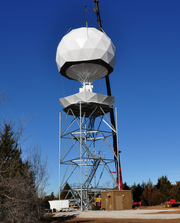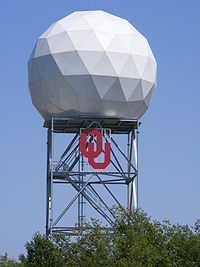
OU-PRIME
Encyclopedia





Atmospheric Radar Research Center
The Atmospheric Radar Research Center is an interdisciplinary research center of the University of Oklahoma located at the National Weather Center in Norman, Oklahoma...
(ARRC) at the University of Oklahoma
University of Oklahoma
The University of Oklahoma is a coeducational public research university located in Norman, Oklahoma. Founded in 1890, it existed in Oklahoma Territory near Indian Territory for 17 years before the two became the state of Oklahoma. the university had 29,931 students enrolled, most located at its...
(OU). The radar was built to provide OU students and faculty a platform for research and education in the field of radar meteorology. This C-band polarimetric radar
Radar
Radar is an object-detection system which uses radio waves to determine the range, altitude, direction, or speed of objects. It can be used to detect aircraft, ships, spacecraft, guided missiles, motor vehicles, weather formations, and terrain. The radar dish or antenna transmits pulses of radio...
has the highest resolution of any C-band, polarimetric, research, weather radar in the United States and possibly the world.
System characteristics
OU-PRIME, aka OU', is located on the Research Campus of the University of OklahomaUniversity of Oklahoma
The University of Oklahoma is a coeducational public research university located in Norman, Oklahoma. Founded in 1890, it existed in Oklahoma Territory near Indian Territory for 17 years before the two became the state of Oklahoma. the university had 29,931 students enrolled, most located at its...
within walking distance of the National Weather Center
National Weather Center
The National Weather Center , located on the campus of the University of Oklahoma, is a confederation of federal, state, and academic organizations that work together in partnership to improve understanding of events occurring in Earth's atmosphere over a wide range of time and space scales...
building. Through a unique design, OU-PRIME can provide real-time time-series data providing opportunities for rapid developments in radar signal processing
Signal processing
Signal processing is an area of systems engineering, electrical engineering and applied mathematics that deals with operations on or analysis of signals, in either discrete or continuous time...
algorithms. Because of its C-band wavelength and 1 MW transmit power, OU-PRIME is extremely sensitive to clouds with approximately 10 dB more sensitivity over the NEXRAD
NEXRAD
NEXRAD or Nexrad is a network of 159 high-resolution Doppler weather radars operated by the National Weather Service, an agency of the National Oceanic and Atmospheric Administration within the United States Department of Commerce...
system (S-band).
Characteristics :
- Location 35°10′48.8"N 97°26′0.6"W
- Radiating Center Height is 80 feet (24.4 m)
- Operating frequency is 5510 MHz (C-band)
- Wavelength: 5.44 cm
- Pulse Length: 0.4, 0.8, 1.0, 2.0 usec
- Pulse Repetition Frequency: 300-2000 Hz, 1-Hz step
- 1 MW Peak Power (magnetron with solid-state modulator)
- 8.5-meter Andrew's precision C-band dish
- High angular resolution: 0.45 degree @ -3 dB points
- Gain: 50 dBi
- Sidelobe Level: Better than -26 dB one-way
- Cross-Pol: Better than -30 dB
- Rotation rate: 6-25 deg/sec under typical scanning (30 deg/sec Max)
- Minimum Detectable Signal: -112 dBm
- Radar Sensitivity: -15 dBZ at 50 km
- Noise Figure: 3 dB
- Simultaneous dual-polarization
- Flexible computing platform for real-time algorithm development
- Real-time I/Q data recording/processing
- A/D converter resolution: 16 bit
- Receiver bandwidth: 6 MHz
- Gate spacing: 25-500 m
- Number of range gates: up to 2200
- Clutter suppression: 60 dB (automatic detection/suppression using CLEAN-AP http://cimms.ou.edu/~torres/dsp_clean_ap.html)
- Advanced signal processing framework based on new STEP algorithm, including clutter estimation/suppression and multi-lag moment estimation
Research and educational pursuits
- An integral part of OU's Weather Radar Curriculum
- Non-precipitating cloud studies
- Advanced signal processingSignal processingSignal processing is an area of systems engineering, electrical engineering and applied mathematics that deals with operations on or analysis of signals, in either discrete or continuous time...
algorithm development (e.g. DopplerDoppler effectThe Doppler effect , named after Austrian physicist Christian Doppler who proposed it in 1842 in Prague, is the change in frequency of a wave for an observer moving relative to the source of the wave. It is commonly heard when a vehicle sounding a siren or horn approaches, passes, and recedes from...
spectrum) - Weather radar polarimetryPolarimetryPolarimetry is the measurement and interpretation of the polarization of transverse waves, most notably electromagnetic waves, such as radio or light waves...
/ QPE - Next-generation digital receiver design
- Severe weatherSevere weatherSevere weather phenomena are weather conditions that are hazardous to human life and property.- Examples Include :Severe weather can occur under a variety of situations, but three characteristics are generally needed: a temperature or moisture boundary, moisture, and , instability in the...
detection algorithms based on spectral processing - PrecipitationPrecipitation (meteorology)In meteorology, precipitation In meteorology, precipitation In meteorology, precipitation (also known as one of the classes of hydrometeors, which are atmospheric water phenomena is any product of the condensation of atmospheric water vapor that falls under gravity. The main forms of precipitation...
microphysics - Radar-based aerobiologyAerobiologyAerobiology is a branch of biology that studies organic particles, such as bacteria, fungal spores, very small insects, pollen grains and viruses, which are passively transported by the air...
- Adaptive real-time processing
- Cloud physicsCloud physicsCloud physics is the study of the physical processes that lead to the formation, growth and precipitation of clouds. Cloud formations are composed of microscopic droplets of liquid water , tiny crystals of ice , or both...
and electrificationElectrificationElectrification originally referred to the build out of the electrical generating and distribution systems which occurred in the United States, England and other countries from the mid 1880's until around 1940 and is in progress in developing countries. This also included the change over from line... - Storm dynamics

